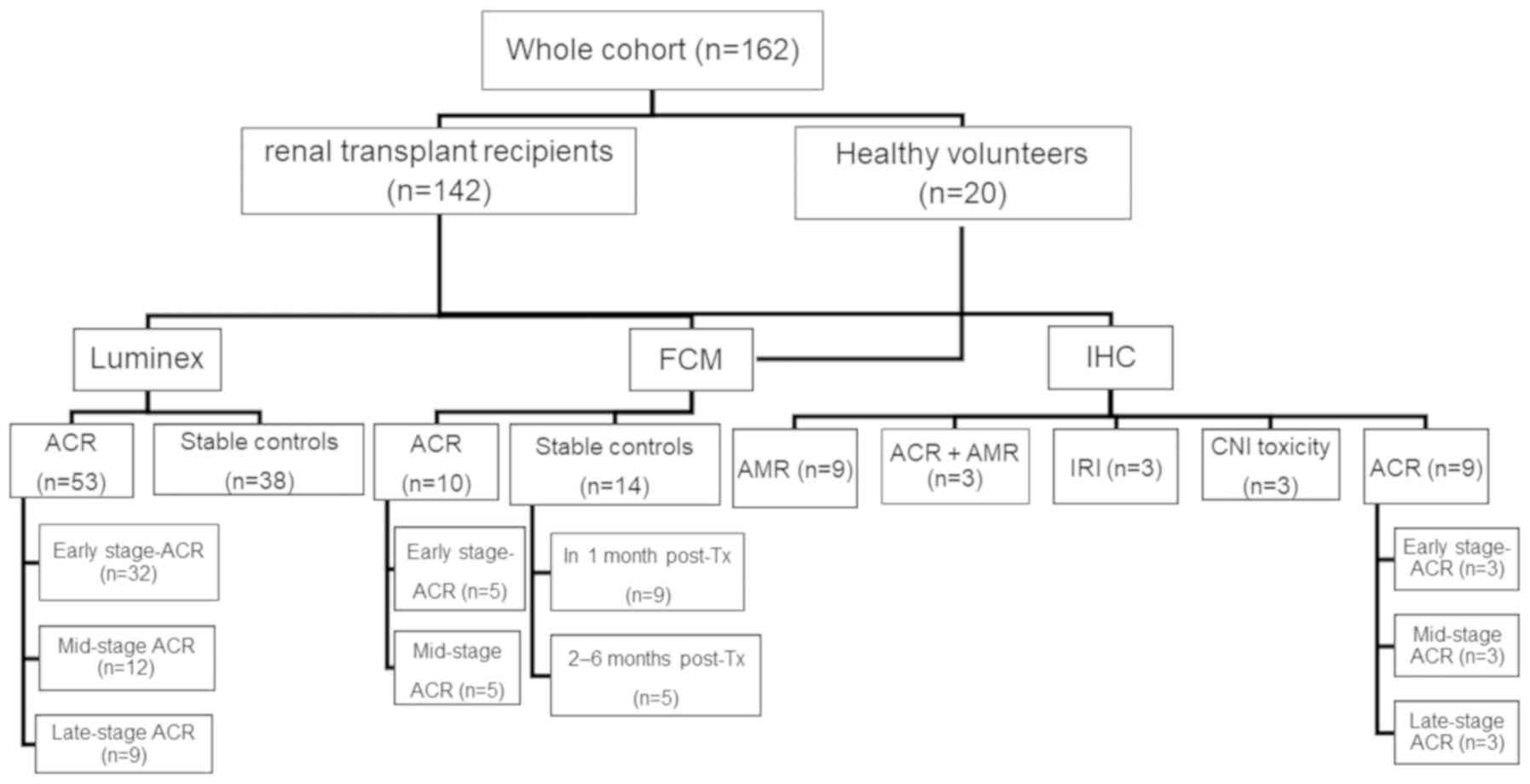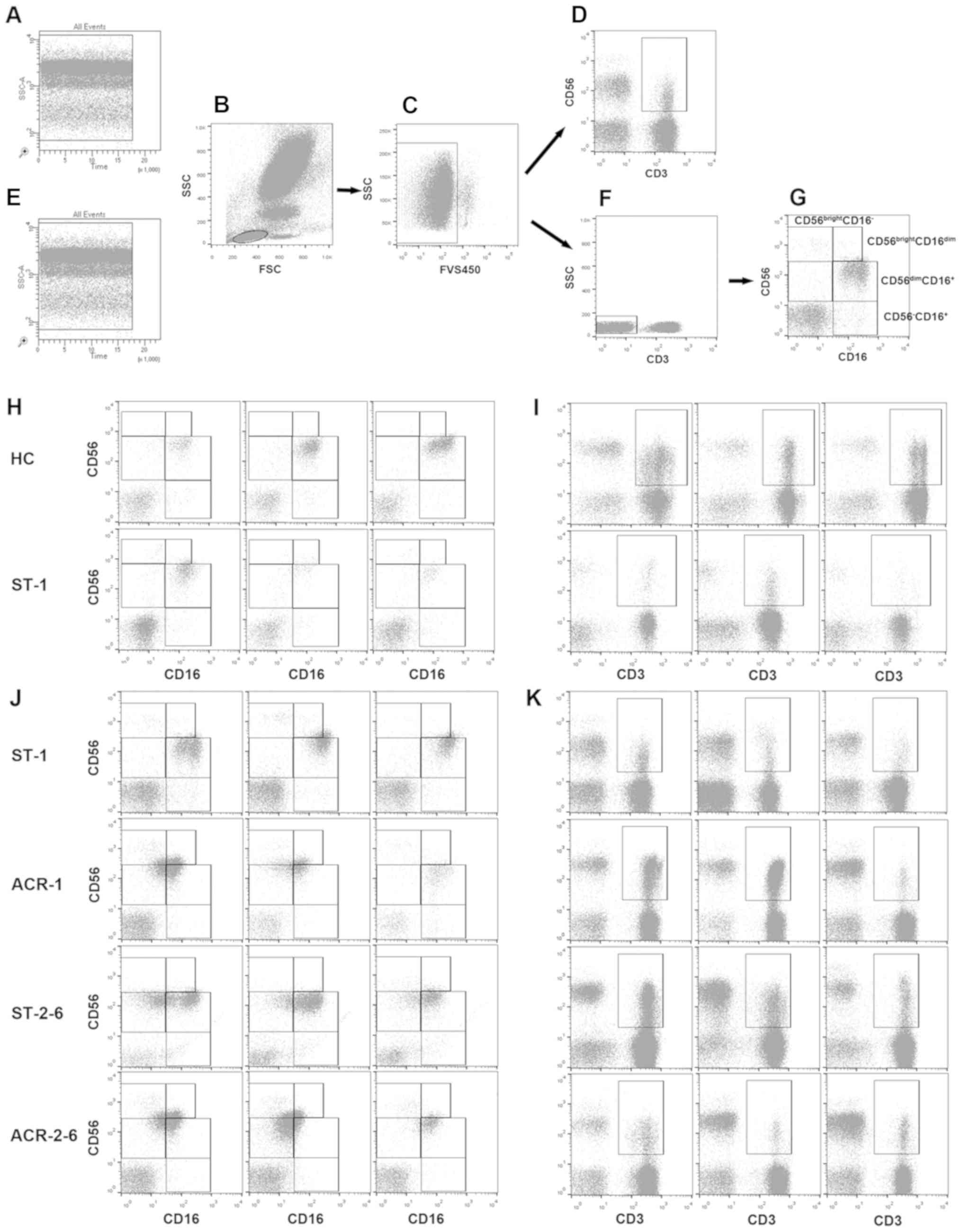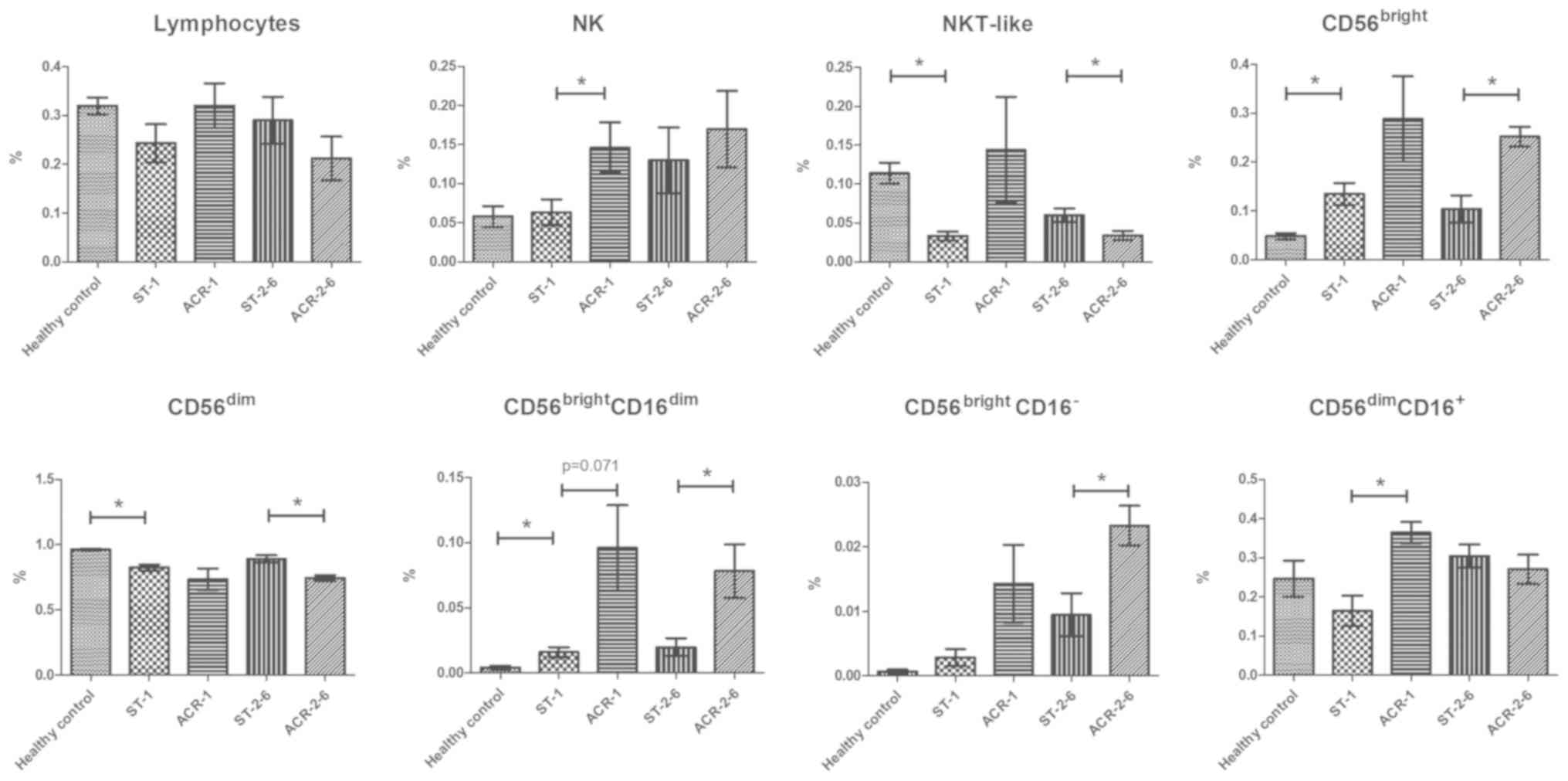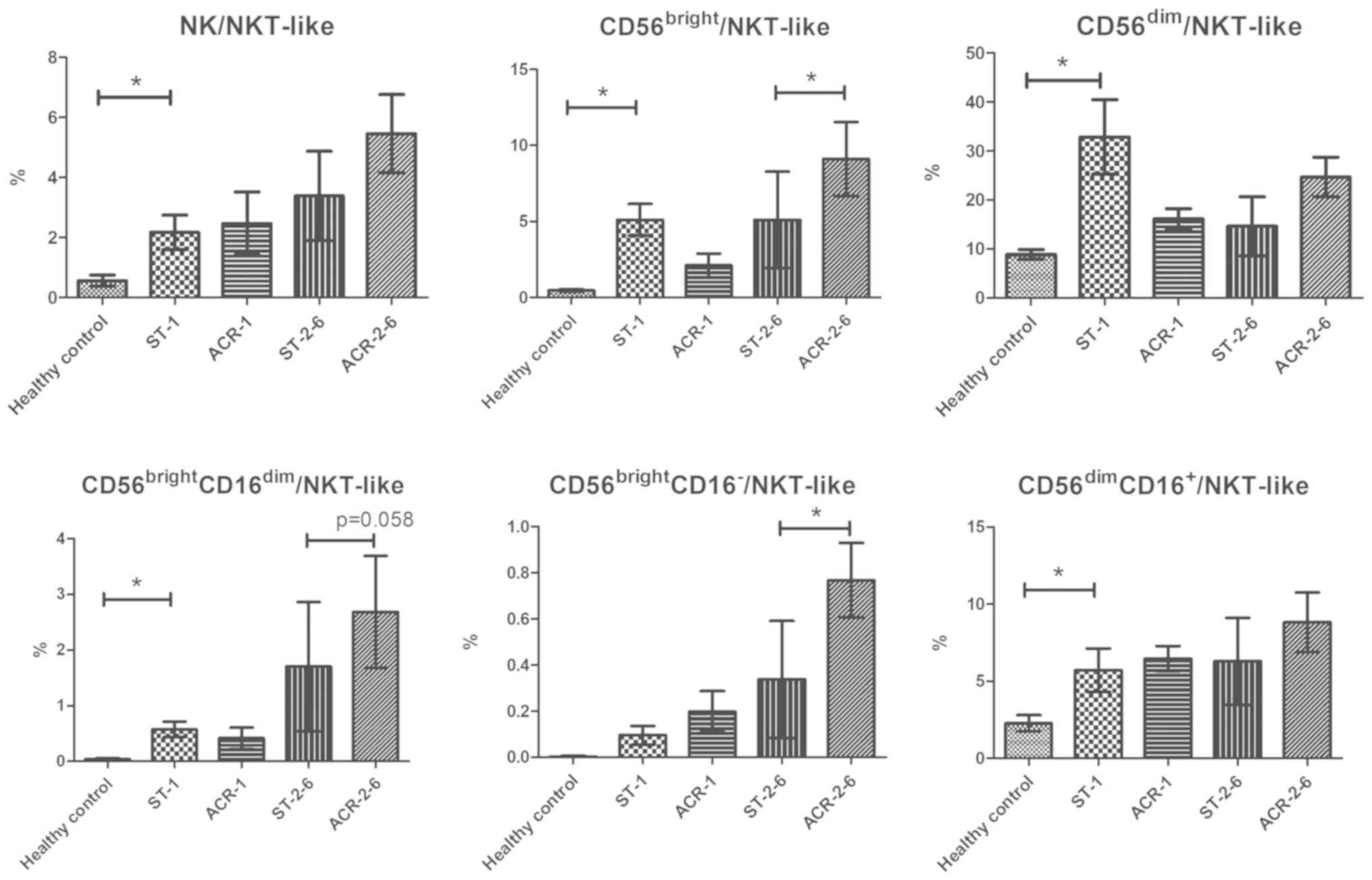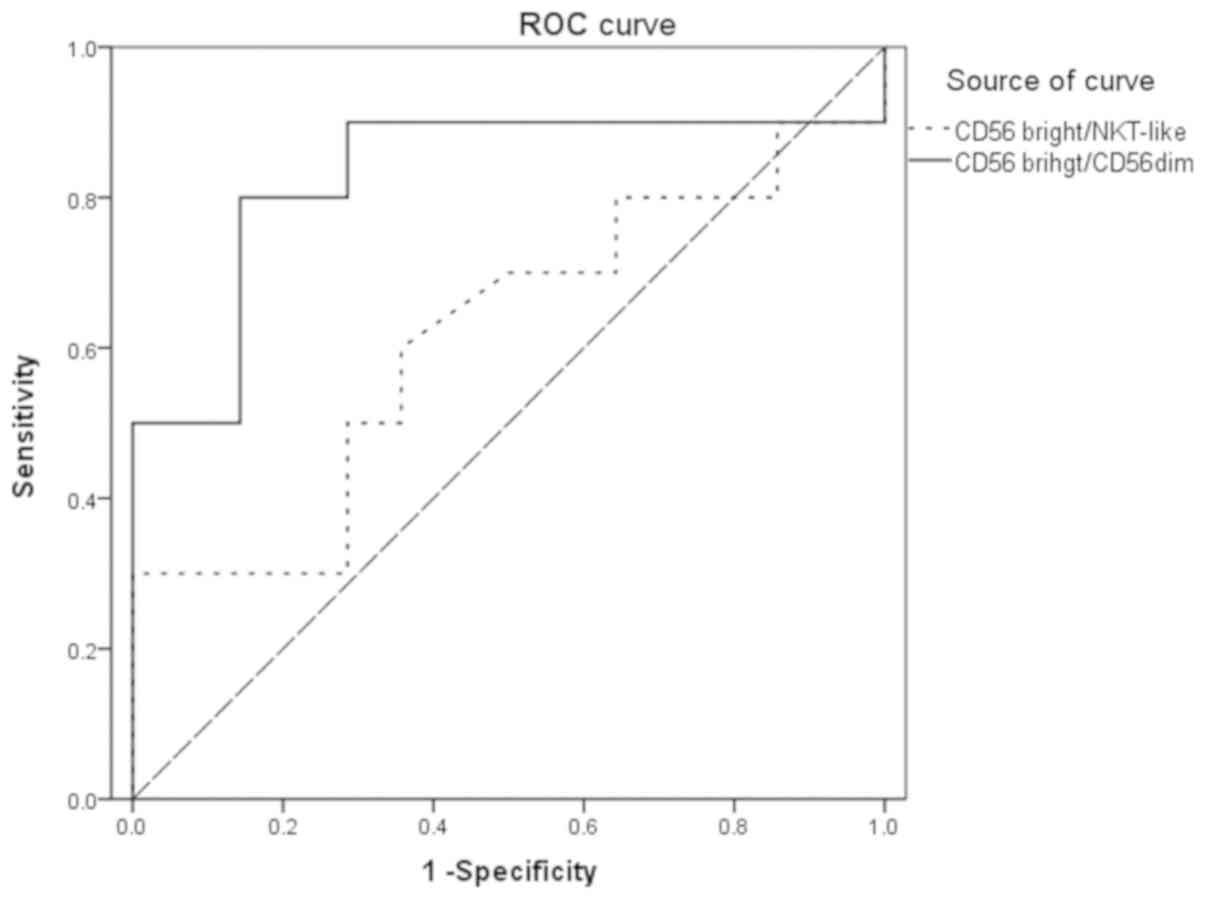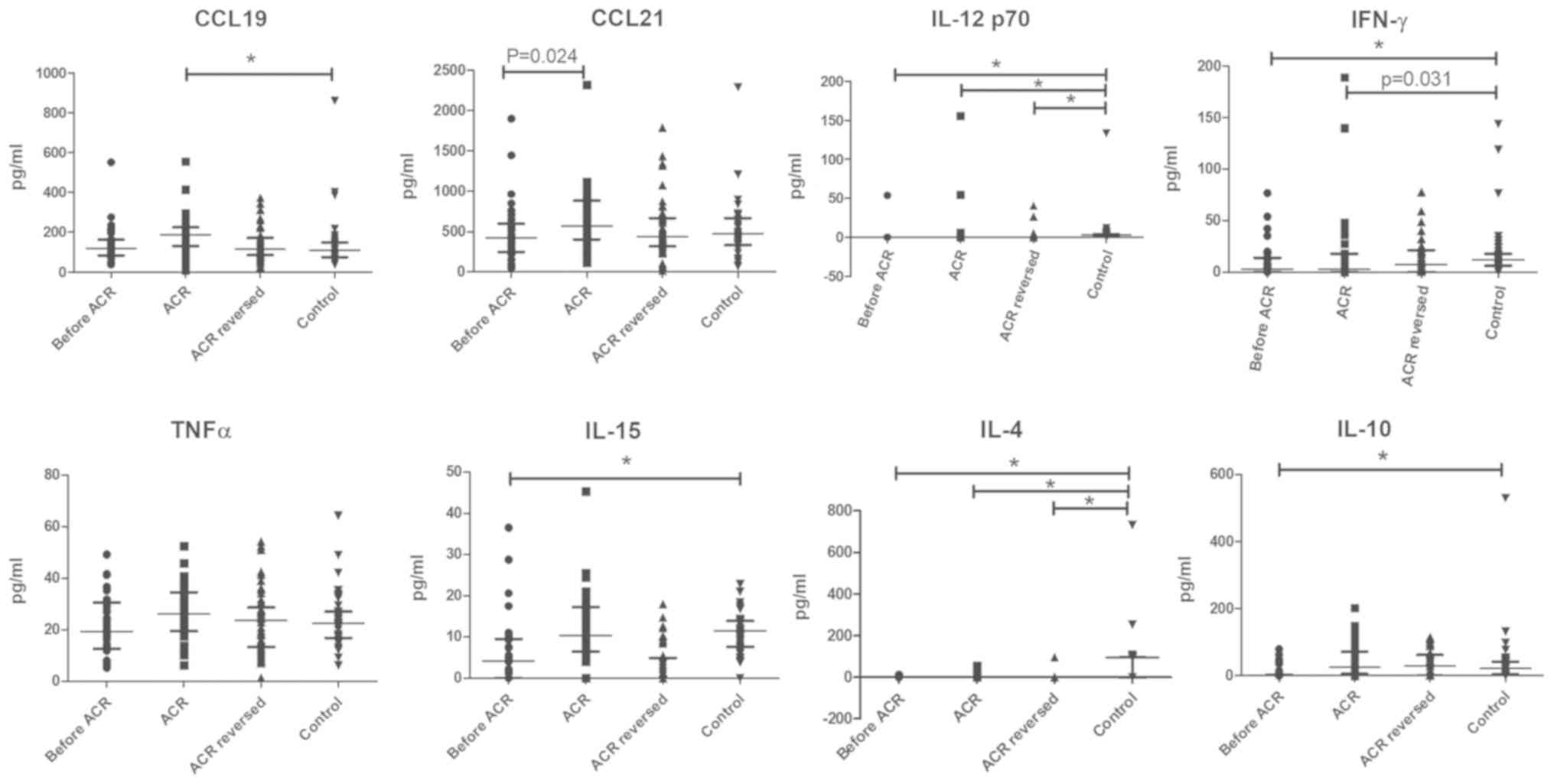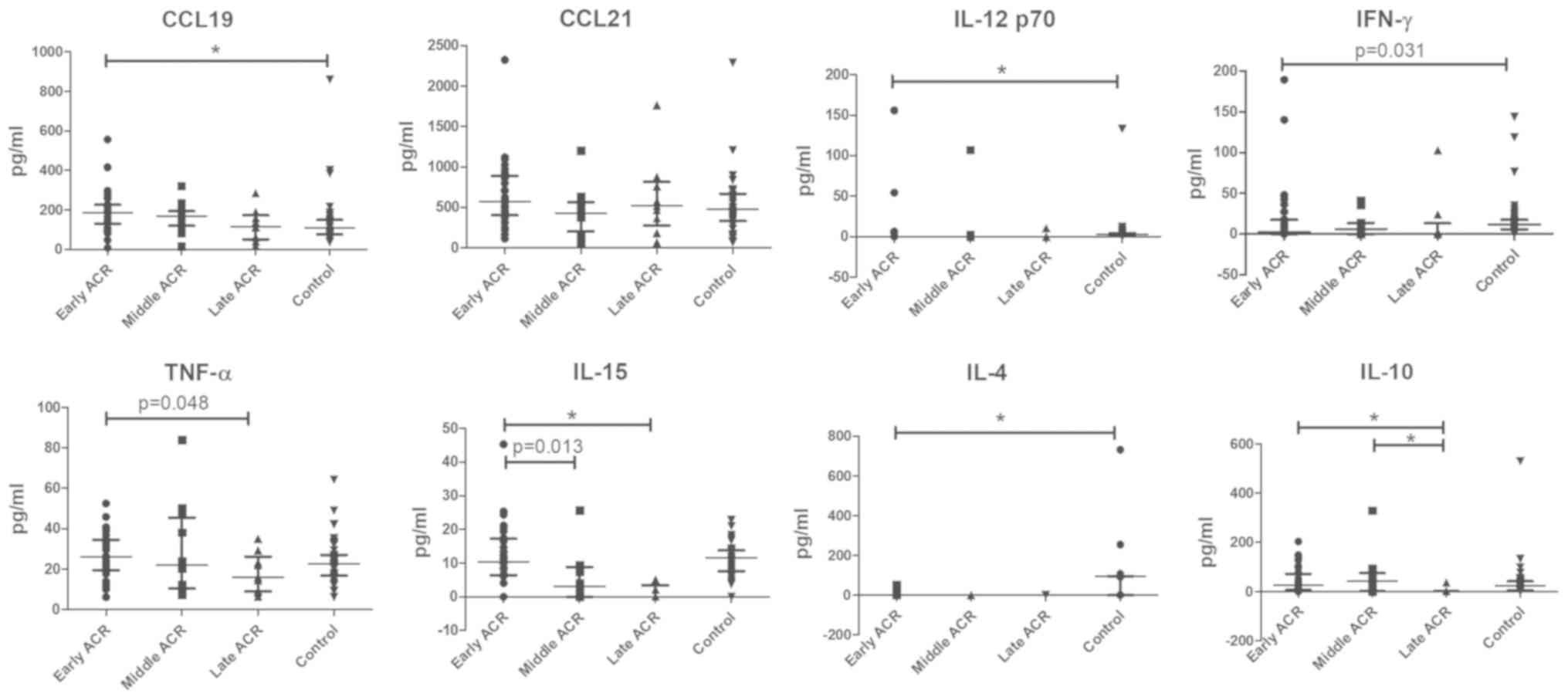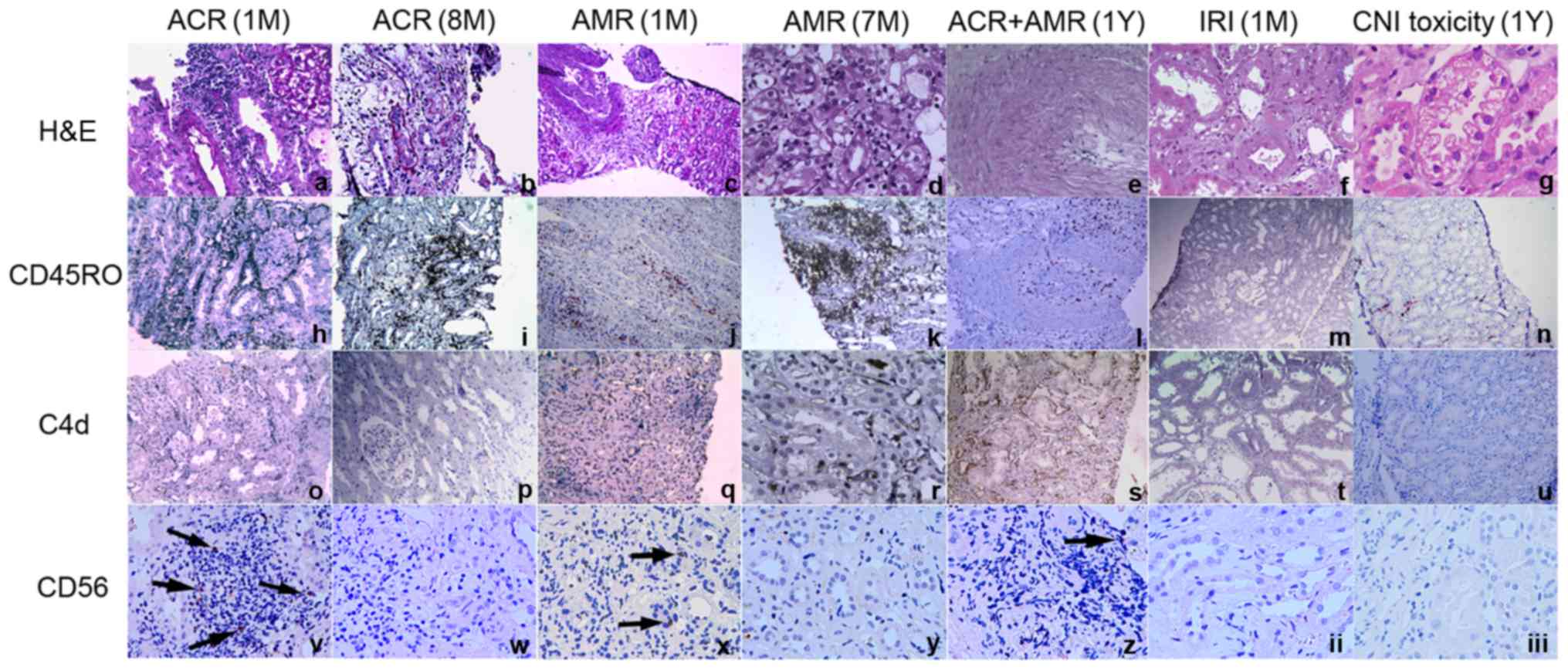Circulating NK cell subsets and NKT‑like cells in renal transplant recipients with acute T‑cell‑mediated renal allograft rejection
- Authors:
- Published online on: March 27, 2019 https://doi.org/10.3892/mmr.2019.10091
- Pages: 4238-4248
-
Copyright: © Xu et al. This is an open access article distributed under the terms of Creative Commons Attribution License.
Abstract
Introduction
In the context of kidney transplantation, the interactions between the innate and adaptive alloimmune responses have not yet been fully investigated. Cytotoxic type 1 innate lymphoid cells, NK cells and NKT cells may represent an interaction between innate immune activity and adaptive alloimmune response, as these cells have the ability to distinguish allogeneic cells from self-cells. In previous studies, NK cells have also been demonstrated to serve a paradoxical role in allograft acceptance and dysfunction in solid organ transplantation through their effect on the immune pathways involved in allograft tolerance and rejection (1–3). Several studies have also indicated that NK cells alone are not sufficient for direct rejection of a solid allograft, but that they participate in the acute rejection response by facilitating the action of alloreactive T cells, supporting the maturation of immature recipient dendritic cells and upregulating MHC class II expression on the graft endothelium by producing interferon-γ (IFN-γ) (1). In addition, host NK cells have been demonstrated to contribute to the induction of transplant tolerance by limiting the persistence of donor-derived dendritic cells through their killing of allogeneic antigen-presenting cells (2,4).
Human NK cells are typically divided into two phenotypic subsets, based on the level of neural cell adhesion molecule 1 (CD56) and low affinity immunoglobulin gamma Fc region receptor III (FcγRIII/CD16) expression: CD56dimCD16+ and CD56brightCD16−/+. The CD56dimCD16+ population is cytotoxic and forms at least 90% of all peripheral blood NK cells. By contrast, CD56bright NK cells, which express low levels of CD16, are less cytotoxic but produce immunoregulatory cytokines, including IFN-γ, following activation in response to stimulation with cytokines, including interleukin (IL)-2, IL-12 and IL-15, and are less cytotoxic compared with CD56dim NK cells. By contrast, NK cells from secondary lymphoid tissues and from other tissues, including the liver and uterus, primarily exhibit the CD56bright phenotype (5). Increasing evidence has indicated that alloantibodies may trigger NK cell activation via FcγRIIIA and contribute to antibody-mediated rejection via antibody-dependent cell-mediated cytotoxicity and cytokine production (3). Additionally, lower NK cell numbers and increased proportions of CD56bright NK cells were identified in donor-specific antibody (DSA)-positive kidney transplant recipients; this may indicate improved antibody-dependent turnover following activation via CD16 (6). Similarly, increased percentages of the CD56bright NK subset were identified in kidney transplant recipients with progressive chronic allograft dysfunction (7). However, studies examining the frequency and phenotype of NK cells in acute T-cell-mediated renal allograft rejection (ACR) is rare. Assessment of the circulating NK cell subsets in renal allograft recipients may contribute to defining signature alloreactive responses.
CD56bright NK cells are enriched in the majority of human tissues, with the exception of blood, and represent the majority of NK cells. CD56bright NK cells appear to be outnumbered by CD56dim NK cells in the lung, kidney, mammillary tissue, bone marrow and spleen, but this may be a reflection of the high rate of blood perfusion in these organs (8,9). In addition, unique subsets of tissue-resident CD56bright NK cells have been described in the lymphoid tissue, liver and uterus (9). Shin et al (10) demonstrated that CD56+ cell infiltration in kidney allografts is associated with poor death-censored graft survival. However, studies concerning the distribution of tissue-resident CD56+ NK cells in kidney allografts with ACR are limited.
NKT cells constitute a conserved T cell sublineage with unique properties, including reactivity against a synthetic glycolipid presented by cluster of differentiation 1 (CD1)d, expression of an invariant T cell antigen receptor α chain and unusual requirements for thymic selection. NKT cells have been indicated to serve key roles in the maintenance of allograft tolerance by producing IL-10, and interacting with regulatory T cells (Treg) cells by altering Treg cell function (2,11). For example, Hongo et al (11) identified that IL-4 produced by NKT cells may affect IL-10 production in Tregs (12–14). However, there are few studies on the role of NKT-like cells in ACR. As CD3+CD56+ NKT-like cells are not classical invariant NKT cells, but represent a broader group of T cells matching the original definition of NKT cells (15,16), the present study measured the levels of CD3+CD56+ NKT-like cells and considered them to be indicative of the levels of NKT cells.
Acute rejection (AR) is an allograft-destructive immune response that usually occurs in the first month following transplantation, but may arise at any time during the life-span of a renal transplant. Depending on the dominant mechanism, morphological characteristics and the primary site of injury, AR is sub-categorized into ACR and antibody-mediated allograft rejection (AMR). Quite often, a combination of several mechanisms with different types graft damage occur simultaneously or consecutively, which result in AMR coexisting with ACR. The Banff classification schemes have evolved for the assessment and grading of allograft rejection: The diagnosis and grading of ACR is based on the presence and degree of interstitial inflammation, tubulitis and endothelialitis in the renal allograft. Present criteria require the presence of all 3 of the following elements for a confirmed diagnosis of AMR: i) Evidence of antibody interaction with vascular endothelium, in particular complement 4 molecule C4d deposition; ii) morphologic evidence of acute tissue injury (capillaritis, fibrin thrombi and tubular injury/necrosis); and iii) donor-specific antibodies (17,18).
In the present study, longitudinal changes in NK cell and NKT-like cell frequency and phenotype in the blood and kidney allograft tissue in the first year following transplantation were assessed, and their associations with ACR were explored. Furthermore, the serum concentrations of the NK- and NKT-associated chemokines and cytokines C-C motif ligand (CCL) 19, CCL21, IFN-γ, tumor necrosis factor-α (TNF-α), IL-2, IL-10, IL-12 and IL-15 were assessed in patients at different stages of ACR and stable controls, as CD56bright NK cells have been demonstrated to produce high levels of the pro-inflammatory cytokines IFN-γ and TNF-α, and notably, IL-12 (19,20). In addition, IL-15 is a key cytokine involved in the expansion, survival and function of NKT cells (21,22), and IL-10 may function as an effector cytokine of NKT-cell-mediated transplant tolerance (12). Finally, CCL19 and CCL21 are ligands of C_C chemokine receptor type 7 (CCR7), which is homing receptor of CD56bright NK cells.
Materials and methods
Patients
The present study was conducted on 142 renal transplant recipients [72 patients with ACR, 9 patients with AMR, 3 patients with ACR and AMR, 52 recipients with stable renal allograft function, 3 patients with ischemia reperfusion injury (IRI) and 3 patients with calcineurin inhibitor (CNI) toxicity] who underwent renal transplant procedures at The 309th Hospital of the Chinese People's Liberation Army (Beijing, China) and 20 healthy volunteers. The patients with ACR were divided as follows: Early-stage ACR, when ACR occurred within the first month after transplantation; mid-stage ACR, between 2 and 6 months after transplantation; and late-stage ACR, between 6 and 12 months after transplantation. Recipients with stable renal allograft function were classified into two groups: Patients who were in the first month following transplantation (n=47) and patients who were between 2–6 months following transplantation (n=5). These were recruited as the stable controls for the early-stage ACR and mid-stage ACR groups, respectively (Fig. 1) (23). Healthy control subjects were recruited from staff from The 309th Hospital of the Chinese People's Liberation Army, and were age- and sex-matched to the transplant cohort. All protocols were approved by the Ethics Committee of The 309th Hospital of the Chinese People's Liberation Army, and all patients and the healthy volunteers provided informed consent for the use of samples for research. All donors provided informed consent for kidney tissue donation. All patients received standard triple therapy that consisted of cyclosporin A (CsA) or FK506 and mycophenolate mofetil and steroids. CsA was initiated at 6–8 mg/kg/d and FK506 at 0.05–0.25 mg/kg/d. The drug dosage was adjusted according to the plasma concentration. The target plasma concentration for CsA and FK506 was 200–350 and 10–15 µg/l, respectively, during the first month following transplantation; 150–300 and 8–15 µg/l, respectively, from the second to the third month; 100–250 and 5–12 µg/l, respectively, from the fourth to the twelfth month; and around 50 and 5–10 µg/l, respectively, after the first year. MMF was started at 1.5–2 g/d for half a month and maintained at 1 g/d thereafter. Methylprednisolone, 8–10 mg/kg/day for 3 days and prednisone gradually reduced to 10 mg/day. Patient characteristics are summarized in Table I.
Tissue sampling and patient information
Tissues were obtained from patients with early-stage ACR (n=3), mid-stage ACR (n=3), late-stage ACR (n=3), early-stage AMR (n=3), mid-stage AMR (n=3), late-stage AMR (n=3), ACR and AMR (n=3), IRI (within 1 month after kidney transplantation; n=3) and CNI toxicity (2–6 months after kidney transplantation; n=3). Kidney transplant biopsy samples were obtained from The 309th Hospital of the Chinese People's Liberation Army between 2013 and 2016. Graft rejection was assessed based on the Banff 2013 classification (17).
Flow cytometry
Peripheral blood samples were obtained from patients with early-stage ACR (n=5), mid-stage ACR (n=5), recipients with stable renal allograft function within the first month after transplantation (n=9), recipients with stable renal allograft function between 2–6 months after transplantation (n=5) and healthy volunteers (n=20). Peripheral blood mononuclear cells (PBMCs) were separated from heparinized venous blood samples by density gradient centrifugation (Centrifuged at 400 × g for 30–40 min at 18–20°C) over Ficoll-Uropoline (Ficoll Paque Plus; GE Healthcare, Uppsala, Sweden). Subsequently, cell viability was assessed with fixable viability stain450 (FVS450; cat. no. 562247) and PBMCs were stained for 30 min at 4°C extracellularly with anti-human CD3-fluorescein isothiocyanate (1:5; cat. no. 340542), anti-human CD56-allophycocyanin (1:5; cat. no. 555518), anti-human CD16-phycoerythrin-cy7 (1:20; cat. no. 557744) or the respective isotype control antibodies such as mouse IgG1-FITC (1:100; cat. no. 554679), mouse IgG1-APC (1:5; cat. no. 555751), and mouse IgG1-PE-Cy™7 (1:20; cat. no. 557872; all from BD Pharmingen; BD Biosciences, Franklin Lakes, NJ, USA). NK cell and NKT-like cell subset distribution was then assessed by flow cytometry using FACSCantoII Plus™ and FACSCalibur (BD Biosciences) and analyzed with the FlowJo software (vX.0.7; Tree Star, Inc., Ashland, OR, USA). The gating strategy used to identify subsets was performed according to a previously described protocol (24). Representative images of the gating strategies used to identify subsets are presented in Fig. 2. NK cells were identified as CD3−CD56+ cells, and NKT-like cells were identified as CD3+CD56+ cells. PBMCs from healthy controls and the stable controls were analyzed again independently from the ACR group using the same gating strategies (Fig. 2). The frequency of NK and NKT-like cells was expressed as the percentage of total cells by sequential gating of lymphocyte populations.
Serum chemokine and cytokine analysis
Serum samples were separated from peripheral blood samples, which were collected from 38 recipients with stable graft function, 32 patients with early-stage ACR, 12 patients with mid-stage ACR and 9 patients with late-stage ACR. Peripheral blood samples were taken at several time points and frozen at −80°C until subsequent use. For the present study, pre-ACR samples prior to rejection (serum creatinine, <103 µM), and at the time of ACR, prior to the initiation of antirejection therapy, and following the reversal of rejection (serum creatinine, <103 µM) were selected. For patients with stable graft function, follow-up time points matching the rejection time points were selected. Serum samples were assayed to measure the levels of IL-4, IL-10, IL-12p70, IL-15, CCL19, CCL21, IFN-γ and TNF-α using a human cytokine multiplex immunoassay (MILLIPLEX® MAP kit; Merck KGaA, Darmstadt, Germany) with the Luminex 200 system (Luminex Corp., Austin, TX, USA), as described previously (25). The observed intensities of duplicate samples were averaged and mapped to a fitted curve derived from a serial dilution series of known cytokine standards (26). In addition, recipients with stable graft function were considered as negative controls.
Immunohistological analysis
The renal cortex of freshly explanted allograft or control kidneys was dissected and fixed in 10% neutral buffered formalin for 24 h at room temperature, then embedded in paraffin. Paraffin sections were each cut at a thickness of 2 µm and mounted on positively-charged slides. All slides were stained with hematoxylin (cat. no. ZLI 9608) and eosin (cat. no. ZLI 9613; both OriGene Technologies, Inc., Beijing, China) for 3–5 min at room temperature and used for grading of acute rejection and the controls (IRI and CNI toxicity). Histopathological evaluations were performed by two pathologists who specialized in rejection diagnosis according to the Banff 2013 classification (17), by observation through an Olympus CX51 light microscope (original magnification, ×100, ×200 or ×400, Olympus Corporation, Tokyo, Japan). Indirect immunoperoxidase staining was performed with the following primary antibodies: Mouse anti-human protein tyrosine phosphatase, receptor type, C (clone UCHL1; OriGene Technologies, Inc.), rabbit anti-human CD56 (clone UMAB83; OriGene Technologies, Inc.) and rabbit anti-human C4d (polyclonal; Biomedica Medizinprodukte GmbH & Co KG, Vienna, Austria). Incubation with the primary antibody was followed by single-antigen detection with a biotin-free polymer-based system (PV-9000 Detection System OriGene Technologies, Inc. Negative control experiments were performed by omitting the primary antibody.
Statistical analysis
The levels of cytokines and chemokines were expressed as the median and interquartile range (pg/ml). Receiver operating characteristic (ROC) curves were created to determine the diagnostic value of the ratios of CD56bright NK/NKT-like cell and CD56bright/CD56dim cell in distinguishing between patients with ACR and the control group. To compare serum concentrations of cytokines and chemokines between groups, the Kruskal-Wallis test followed by Mann-Whitney post-hoc tests with a Bonferroni adjustment to the level of significance (P=0.05/k=0.05/6=0.008, where k represents the number of pairwise comparisons) was utilized (27). For all other data in which statistics were performed, including the proportions of the cell subsets and the ratios, two-tailed nonparametric Mann-Whitney U-tests were used to evaluate the differences in variables between patients with ACR and the control groups. P<0.05 was considered to indicate a statistically significant difference. All statistical analyses were performed using SPSS 13.0 software (SPSS Inc., Chicago, IL, USA).
Results
Clinical characteristics and background variables
Patients with stable graft function and acute renal allograft rejection did not differ with respect to age, sex or the immunosuppressive protocol employed (Table I).
Increased proportions of CD56bright cells and decreased proportions of CD56dim cells in the peripheral blood of kidney transplant recipients
To evaluate the immune status of kidney transplant recipients, the proportions of lymphocytes, T cells and NK cell subsets were analyzed. In contrast to the healthy controls, the kidney transplant recipients exhibited increased proportions of CD56bright subsets (P=0.018), in particular the CD56brightCD16dim cells (P=0.029), and decreased proportions of CD56dim subsets (P=0.0001). However, the proportion of lymphocytes and CD3−CD56+ NK cells was similar between the two groups. In addition, the CD56bright/CD56dim ratio was significantly increased in the transplant recipients (P=0.002; Fig. 3).
Increase in the CD3−CD56bright subset frequency and decrease in the CD3−CD56dim subset frequency in PBMCs from recipients with middle-stage ACR
The proportions of peripheral blood NK cell subsets in the 24 kidney transplant recipients (5 patients with early-stage ACR, 5 patients with middle-stage ACR, 9 recipients with stable renal allograft function within 1 month after transplantation and 5 recipients with stable renal allograft function between 2–6 months after transplantation) and 20 healthy volunteers were analyzed by flow cytometric detection of CD56 and CD16 expression. Compared with the recipients with stable graft function, patients with early-stage ACR exhibited increased proportions of NK cells (P=0.026). In addition, an increase in the percentage of CD56brightCD16dim cells was observed in transplant patients with early-stage ACR compared with the controls (P=0.071), but the increase was not statistically significant (Fig. 2). There was a significant increase in the percentage of CD56dimCD16+ cells in transplant patients with early-stage ACR compared with the controls (P=0.014). Notably, compared with the recipients with stable graft function, patients with middle-stage ACR exhibited a greater proportion of CD56brightCD16− (P=0.016) and CD56brightCD16dim subsets (P=0.045), which was associated with an increase in the CD56bright/CD56dim ratio compared with the controls (P=0.008). In addition, a decreased frequency of CD56dimCD16+ cells (P=0.079) and CD56−/CD16+ cells (P=0.071) was observed in transplant patients with middle-stage ACR compared with the controls (Fig. 3).
Decreased CD3+CD56+ NKT-like cell proportions in patients with middle-stage ACR
Analysis of the distribution of CD3+CD56+ NKT-like cells in the PBMCs of kidney transplant recipients indicated that there was a significant decrease in the proportion of NKT-like cells in the PBMCs of kidney transplant recipients compared with the healthy controls. In addition, there was a trend towards increase in the percentage of NKT-like cells (P=0.092) in transplant patients with early-stage ACR compared with the controls. However, there was a significant decrease in the percentage of NKT-like cells in transplant patients with middle-stage ACR compared with recipients with stable graft function (P=0.042; Fig. 3).
Increase in CD56bright NK/NKT-like cell ratios in ACR
As it has been demonstrated that CD56bright NK cells may be involved in destructive immune reactions while NKT-like cells may participate in transplant tolerance (10,12), the ratios of CD56bright NK/NKT-like cells in PBMCs were analyzed to determine whether they are useful indexes for the diagnosis or prognosis of ACR. The ratio of NK/NKT-like cells (P=0.025), CD56brightNK/NKT-like cells (P=0.002), CD56brightCD16dimNK/NKT-like cells (P=0.005), CD56dimNK/NKT-like cells (P=0.040), and CD56dimCD16+NK/NKT-like cells (P=0.045) in kidney transplant recipients was markedly increased compared with that in the healthy controls. However, there was no significant difference in the ratios between patients with early-stage ACR and recipients with stable allograft function. Notably, the ratio of CD56bright NK/NKT-like cells (P=0.043) and CD56brightCD16− NK/NKT-like cells (P=0.014) in the PBMCs of patients with middle-stage ACR exhibited a significant increase compared with the stable controls. In addition, there was a significant increase in the ratio of CD56brightCD16dim NK/NKT-like cells in the PBMCs of patients with middle-stage ACR compared with the stable controls (P=0.058; Fig. 4). Finally, the area under the ROC curve (AUC) for the CD56bright NK/NKT-like cell ratios was 0.614, which is decreased compared with that for the CD56bright/CD56dim cell ratio (AUC=0.829; Fig. 5).
Altered serum concentrations of CCL19, IL-15 and IL-10 in patients with ACR at different stages. The serum concentrations of CCL19 in patients with early-stage ACR increased significantly in contrast with the controls who had stable graft function, while the serum concentrations of IL-12p70, IL-4 and IFN-γ in patients with early-stage ACR exhibited a decrease compared with the controls. No significant difference in the serum concentrations of TNF-α and CCL21 between the ACR and control groups was observed. Notably, there was a marked decrease in the serum concentrations of IL-12p70, IFN-γ, IL-15, IL-4 and IL-10 prior to rejection compared with the control (Fig. 6). In addition, the IL-15 and IL-10 levels were markedly decreased in the late-stage ACR group. By contrast, no differences in the serum levels of CCL19, CCL21, IL-12p70 and IFN-γ among the ACR groups at different stages were observed (Fig. 7).
Increase in CD56+ NK cell infiltration in kidney allografts with early-stage ACR
To analyze the local expression of CD56 in renal allografts, the expression levels of CD56 in graft biopsy specimens were detected from the following groups of recipients: Early-stage ACR; mid-stage ACR; late-stage ACR; early-stage AMR; mid-stage AMR; late-stage AMR; ACR and AMR; IRI; and CNI toxicity. Biopsy tissues from patients with early-stage ACR, early-stage AMR, late-stage ACR and AMR were positive for CD56, while those from patients with late-stage ACR, late-stage AMR, IRI and CNI toxicity exhibited a decreased level of infiltration or complete absence of NK cells. Furthermore, in comparison with biopsy tissue from patients with early-stage AMR, samples from patients with early-stage ACR exhibited increased levels of infiltration of CD56+ NK cells (Fig. 8).
Discussion
The results from the present study indicated that recipients with stable graft function had increased proportions of CD56brightCD16dim subsets, and also an increased CD56bright/CD56dim ratio compared with the healthy controls. Similarly, patients with middle-stage ACR exhibited increased proportions of NK cells, which were associated with an increase in the CD3−CD56bright subsets (CD56brightCD16− and CD56brightCD16dim), a decrease in the CD3−CD56dim subsets (CD56dimCD16+) and an increase in the CD56bright/CD56dim ratio compared with the controls. These data contrast those from that of Crespo et al (6) who observed that DSA and HLA non-DSA patients exhibited decreased proportions of NK cells and increased proportions of CD56bright subsets compared with patients without HLA antibodies (6). These results may indicate that there are differences in the NK cell phenotype in the PBMCs of patients with ACR and AMR.
Notably, transplant patients with early-stage ACR did not exhibit a significant increase in the proportion of CD3−CD56bright subsets or the CD56bright/CD56dim ratio compared with stable controls. In addition, more CD56+ NK cells infiltrated the kidney allograft in patients with ACR and AMR in the first 1 month following transplantation, in contrast to stable controls or patients with rejection after 1 month of transplantation. These data imply that CD56bright NK cells may serve important roles in the alloimmune response, which may be important for allograft function in the initiation stage of ACR and AMR, and that they primarily serve a role in the peripheral blood after 1 month post-transplantation.
The specific chemotactic triggers for the movement of NK cells to the kidney allograft remain a topic of study at present. Peripheral CD56brightCD16dim/− NK cells home into tissues including the peripheral lymph nodes and the kidneys under certain physiological conditions via the homing receptor CCR7, through which it responds to the chemokines CCL19 and CCL21 (28). CCR7 has been demonstrated to localize in the blood vessel walls and tubular epithelial cells of renal allografts and to be increasingly expressed in patients with chronic/sclerosing allograft nephropathy in comparison with the normal controls (29). Additionally, it has been suggested that the IFN-γ/C-X-C chemokine receptor type 3 (CXCR3)/C-X-C chemokine (CXCL)9/CXCL10/CXCL11 axis is important for the recruitment of NK cells from storage organs including the bone marrow into blood circulation (28). In the present study, these CD56bright NK cell-associated cytokines were examined in renal allograft recipients, and it was identified that the profiles of patients with ACR exhibited increased serum concentrations of CCL19 compared with those of recipients with stable graft function. There were no significant differences in the serum concentrations of CCL19 and CCL21 between patients at different stages of ACR. In addition, our previous study demonstrated that the serum concentrations of CXCL9, CXCL10 and CXCL11, the CXCR3-specific ligands, measured during an episode of ACR, were significantly increased compared with those of patients with stable function, and that the number of CXCR3+ cells in the graft biopsy specimens from patients with ACR was significantly increased compared with the recipients with stable graft function (30). Therefore, the elevation in the serum concentrations of CCL19, CXCL9, CXCL10, and CXCL11 is consistent with the increase in the frequency of peripheral CD56bright NK cells.
It has been demonstrated that CD56bright NK cells often serve a regulatory role and are primary producers of inflammatory and regulatory cytokines, including IFN-γ, TNF-α and IL-12 (19,20). In the present study, the serum concentrations of IL-12 and IFN-γ were decreased in patients with ACR compared with recipients with stable graft function, but the TNF-a concentration was similar. The reasons for the decreases in the serum concentrations of IL-12 and IFN-γ are complicated, and the present study was not able to determine whether they were secreted by CD56bright NK cells. However, decreases in the levels of IFN-γ secreted from Th1-like Treg cells in patients with ACR may partially explain these data (23).
The frequency of CD3+CD56+ NKT-like cells in the PBMCs of kidney transplant recipients was decreased compared with that of the healthy controls. In addition, the percentage of NKT-like cells in patients with middle-stage ACR was decreased compared with that in recipients with stable graft function. Therefore, NKT-like cells may serve a protective role from the alloimmune response, particularly 1 month after post-translation. Several previous studies have described the regulatory effects of antigen-presenting glycoprotein CD1d-dependent NKT cells on alloantigens, and that these effects were IL-10- or TGF-β-dependent (12,31,32). In addition, NKT cells have been suggested to affect IL-10 production from Tregs via production of IL-4 (12). The results of the present study indicated that there was a marked decrease in the serum concentrations of IL-15, IL-4 and IL-10 prior to rejection compared with the control. The IL-15 and IL-10 levels were also decreased markedly in the late-stage ACR group. The decrease in IL-15 levels prior to an episode of ACR appears to be consistent with the decrease in the circulating proportions of NKT-like cells in patients with ACR, and may potentially explain the decrease in the proportion of NKT-like cells. Furthermore, the decrease in the serum concentrations of IL-4 and IL-10 prior to an episode of ACR may be the result of decrease in the frequency of NKT-like cells in patients and also be responsible for the occurrence of ACR.
The NK/NKT-like, CD56bright NK/NKT-like and CD56dim NK/NKT-like cell ratios in the PBMCs of kidney transplant recipients were increased compared with those in the healthy controls. Additionally, the CD56brightNK/NKT-like cell ratios in the PBMCs of patients with middle-stage ACR also exhibited a significant increase compared with those in the stable controls. Finally, based on the AUC values for the different cell ratios, it appears that the CD56bright/CD56dim ratio and not the CD56brightNK/NKT-like cell ratio may contribute to the ACR occurrence.
In summary, the results of the present study indicate that CD56brightCD16−/dim NK cells promote the development of ACR, and that NKT-like cells may have immunoregulatory function. In addition, the data indicate that the CD56bright/CD56dim ratio may contribute to the ACR patterns. However, as the sample size was small, the results from the present study only provide a basis for subsequent larger-scale and more in-depth studies on the role of NK subsets and NKT cells in ACR.
Acknowledgements
The authors would like to thank Mrs. Yu Gao (Yianbo Biotechnology Company, Henan, China) for her kind help with analyzing certain flow cytometry data.
Funding
The present study was supported by the National Natural Science Foundation of China (grant no. 81571555) and the Capital Characteristic Clinic Project (grant no. Z171100001017185).
Availability of data and materials
All data generated or analyzed during this study are included in this published article.
Authors' contributions
LX designed the study and provided scientific leadership to junior colleagues. BS analyzed the data, collected clinical samples and patients' information, and revised the manuscript. XX analyzed the data and wrote the paper. YH performed the histopathological evaluation and rejection diagnosis. LB performed the immunofluorescent staining and flow cytometry analysis. HH performed the cytokine multiplex immunoassay, XK performed the virus antigen detection assay and XM performed the donor specific antibody detection assay. All authors read and approved the final version of the manuscript.
Ethics approval and consent to participate
The present study was approved by the Ethical Committee of The 309th Hospital of the Chinese People's Liberation Army, and all patients provided informed consent for the use of their samples in this research. All donors provided informed consent for kidney donation.
Patient consent for publication
Not applicable.
Competing interests
The authors declare that they have no competing interests.
Glossary
Abbreviations
Abbreviations:
|
NK |
natural killer cells |
|
ACR |
acute T-cell-mediated renal allograft rejection |
|
early-stage ACR |
ACR occurring within the first month after transplantation |
|
mid-stage ACR |
ACR occurring between 2 and 6 months after transplantation |
|
late-stage ACR |
ACR occurring between 7 and 12 months after transplantation |
|
AMR |
antibody-mediated allograft rejection |
|
ST |
stable control |
|
IRI |
ischemia-reperfusion injury |
|
CNI toxicity |
calcineurin inhibitor toxicity |
|
PBMC |
peripheral blood mononuclear cell |
|
DSA |
donor specific antibody |
References
|
Kitchens WH, Uehara S, Chase CM, Colvin RB, Russell PS and Madsen JC: The changing role of natural killer cells in solid organ rejection and tolerance. Transplantation. 81:811–817. 2006. View Article : Google Scholar : PubMed/NCBI | |
|
Pratschke J, Stauch D and Kotsch K: Role of NK and NKT cells in solid organ transplantation. Transpl Int. 22:859–868. 2009. View Article : Google Scholar : PubMed/NCBI | |
|
López-Botet M, Vilches C, Redondo-Pachón D, Muntasell A, Pupuleku A, Yélamos J, Pascual J and Crespo M: Dual role of natural killer cells on graft rejection and control of cytomegalovirus infection in renal transplantation. Front Immunol. 8:1662017. View Article : Google Scholar : PubMed/NCBI | |
|
Yu G, Xu X, Vu MD, Kilpatrick ED and Li XC: NK cells promote transplant tolerance by killing donor antigen-presenting cells. J Exp Med. 203:1851–1858. 2006. View Article : Google Scholar : PubMed/NCBI | |
|
Michel T, Poli A, Cuapio A, Briquemont B, Iserentant G, Ollert M and Zimmer J: Human CD56bright NK cells: An update. J Immunol. 196:2923–2931. 2016. View Article : Google Scholar : PubMed/NCBI | |
|
Crespo M, Yelamos J, Redondo D, Muntasell A, Perez-Saéz MJ, López-Montañés M, García C, Torio A, Mir M, Hernández JJ, et al: Circulating NK-cell subsets in renal allograft recipients with anti-HLA donor-specific antibodies. Am J Transplant. 15:806–814. 2015. View Article : Google Scholar : PubMed/NCBI | |
|
Assadiasl S, Sepanjnia A, Aghili B, Nafar M, Ahmadpoor P, Pourrezagholi F, Parvin M, Shahlaee A, Nicknam MH and Amirzargar A: Natural killer cell subsets and IL-2, IL-15 and IL-18 genes expressions in chronic kidney allograft dysfunction and graft function in kidney allograft recipients. Int J Organ Transplant Med. 7:212–217. 2016.PubMed/NCBI | |
|
Carrega P, Bonaccorsi I, Di Carlo E, Morandi B, Paul P, Rizzello V, Cipollone G, Navarra G, Mingari MC, Moretta L and Ferlazzo G: CD56(bright)perforin(low) noncytotoxic human NK cells are abundant in both healthy and neoplastic solid tissues and recirculate to secondary lymphoid organs via afferent lymph. J Immunol. 192:3805–3815. 2014. View Article : Google Scholar : PubMed/NCBI | |
|
Melsen JE, Lugthart G, Lankester AC and Schilham MW: Human circulating and tissue-resident CD56 (bright) natural killer cell populations. Front Immunol. 7:2622016. View Article : Google Scholar : PubMed/NCBI | |
|
Shin S, Kim YH, Cho YM, Park Y, Han S, Choi BH, Choi JY and Han DJ: Interpreting CD56+ and CD163+ infiltrates in early versus late renal transplant biopsies. Am J Nephrol. 41:362–369. 2015. View Article : Google Scholar : PubMed/NCBI | |
|
Hongo D, Tang X, Dutt S, Nador RG and Strober S: Interactions between NKT cells and Tregs are required for tolerance to combined bone marrow and organ transplants. Blood. 119:1581–1589. 2012. View Article : Google Scholar : PubMed/NCBI | |
|
Jiang X, Kojo S, Harada M, Ohkohchi N, Taniguchi M and Seino KI: Mechanism of NKT cell-mediated transplant tolerance. Am J Transplant. 7:1482–1490. 2007. View Article : Google Scholar : PubMed/NCBI | |
|
Godfrey DI, MacDonald HR, Kronenberg M, Smyth MJ and Van Kaer L: NKT cells: What's in a name. Nat Rev Immunol. 4:231–237. 2004. View Article : Google Scholar : PubMed/NCBI | |
|
Peng LS, Mao FY, Zhao YL, Wang TT, Chen N, Zhang JY, Cheng P, Li WH, Lv YP, Teng YS, et al: Altered phenotypic and functional characteristics of CD3+CD56+ NKT-like cells in human gastric cancer. Oncotarget. 7:55222–55230. 2016. View Article : Google Scholar : PubMed/NCBI | |
|
Golden-Mason L, Castelblanco N, O'Farrelly C and Rosen HR: Phenotypic and functional changes of cytotoxic CD56pos natural T cells determine outcome of acute hepatitis C virus infection. J Virol. 81:9292–9298. 2007. View Article : Google Scholar : PubMed/NCBI | |
|
Diao H, He J, Zheng Q, Chen J, Cui G, Wei Y, Ye P, Kohanawa M and Li L: A possible role for NKT-like cells in patients with chronic hepatitis B during telbivudine treatment. Immunol Lett. 160:65–71. 2014. View Article : Google Scholar : PubMed/NCBI | |
|
Haas M, Sis B, Racusen LC, Solez K, Glotz D, Colvin RB, Castro MC, David DS, David-Neto E, Bagnasco SM, et al: Banff 2013 meeting report: Inclusion of c4d-negative antibody-mediated rejection and antibody-associated arterial lesions. Am J Transplant. 14:272–283. 2014. View Article : Google Scholar : PubMed/NCBI | |
|
Haas M, Loupy A, Lefaucheur C, Roufosse C, Glotz D, Seron D, Nankivell BJ, Halloran PF, Colvin RB, Akalin E, et al: The banff 2017 kidney meeting report: Revised diagnostic criteria for chronic active T cell-mediated rejection, antibody-mediated rejection and prospects for integrative endpoints for next-generation clinical trials. Am J Transplant. 18:293–307. 2018. View Article : Google Scholar : PubMed/NCBI | |
|
Fehniger TA, Shah MH, Turner MJ, VanDeusen JB, Whitman SP, Cooper MA, Suzuki K, Wechser M, Goodsaid F and Caligiuri MA: Differential cytokine and chemokine gene expression by human NK cells following activation with IL-18 or IL-15 in combination with IL-12: Implications for the innate immune response. J Immunol. 162:4511–4520. 1999.PubMed/NCBI | |
|
Márquez ME, Millet C, Stekman H, Conesa A, Deglesne PA, Toro F, Sanctis JD and Blanca I: CD16 cross-linking induces increased expression of CD56 and production of IL-12 in peripheral NK cells. Cell Immunol. 264:86–92. 2010. View Article : Google Scholar : PubMed/NCBI | |
|
Bendelac A, Savage PB and Teyton L: The biology of NKT cells. Annu Rev Immunol. 25:297–336. 2007. View Article : Google Scholar : PubMed/NCBI | |
|
Lin SJ, Huang YC, Cheng PJ, Lee PT, Hsiao HS and Kuo ML: Interleukin-15 enhances the expansion and function of natural killer T cells from adult peripheral and umbilical cord blood. Cytokine. 76:348–355. 2015. View Article : Google Scholar : PubMed/NCBI | |
|
Xu X, Huang H, Wang Q, Cai M, Qian Y, Han Y, Wang X, Gao Y, Yuan M, Xu L, et al: IFN-γ-producing Th1-like regulatory T cells may limit acute cellular renal allograft rejection: Paradoxical post-transplantation effects of IFN-γ. Immunobiology. 222:280–290. 2017. View Article : Google Scholar : PubMed/NCBI | |
|
Poli A, Michel T, Thérésine M, Andrès E, Hentges F and Zimmer J: CD56bright natural killer (NK) cells: An important NK cell subset. Immunology. 126:458–465. 2009. View Article : Google Scholar : PubMed/NCBI | |
|
Xu X, Huang H, Cai M, Qian Y, Li Z, Bai H, Han Y, Xiao L, Zhou W, Wang X and Shi B: Combination of IL-1 receptor antagonist, IL-20 and CD40 ligand for the prediction of acute cellular renal allograft rejection. J Clin Immunol. 33:280–287. 2013. View Article : Google Scholar : PubMed/NCBI | |
|
Cassano P, Bui E, Rogers AH, Walton ZE, Ross R, Zeng M, Nadal-Vicens M, Mischoulon D, Baker AW, Keshaviah A, et al: Inflammatory cytokines in major depressive disorder: A case-control study. Aust N Z J Psychiatry. 51:23–31. 2017. View Article : Google Scholar : PubMed/NCBI | |
|
Curran-Everett D: Multiple comparisons: Philosophies and illustrations. Am J Physiol Regul Integr Comp Physiol. 279:R1–R8. 2000. View Article : Google Scholar : PubMed/NCBI | |
|
Maghazachi AA: Role of chemokines in the biology of natural killer cells. Curr Top Microbiol Immunol. 341:37–58. 2010.PubMed/NCBI | |
|
Zhou HL, Wang YT, Gao T, Wang WG and Wang YS: Distribution and expression of fibroblast-specific protein chemokine CCL21 and chemokine receptor CCR7 in renal allografts. Transplant Proc. 45:538–545. 2013. View Article : Google Scholar : PubMed/NCBI | |
|
Huang H, Xu X, Yao C, Cai M, Qian Y, Wang X and Shi B: Serum levels of CXCR3 ligands predict T cell-mediated acute rejection after kidney transplantation. Mol Med Rep. 9:45–50. 2014. View Article : Google Scholar : PubMed/NCBI | |
|
Oh K, Kim S, Park SH, Gu H, Roopenian D, Chung DH, Kim YS and Lee DS: Direct regulatory role of NKT cells in allogeneic graft survival is dependent on the quantitative strength of antigenicity. J Immunol. 174:2030–2036. 2005. View Article : Google Scholar : PubMed/NCBI | |
|
Yang SH, Jin JZ, Lee SH, Park H, Kim CH, Lee DS, Kim S, Chung NH and Kim YS: Role of NKT cells in allogeneic islet graft survival. Clin Immunol. 124:258–266. 2007. View Article : Google Scholar : PubMed/NCBI |



